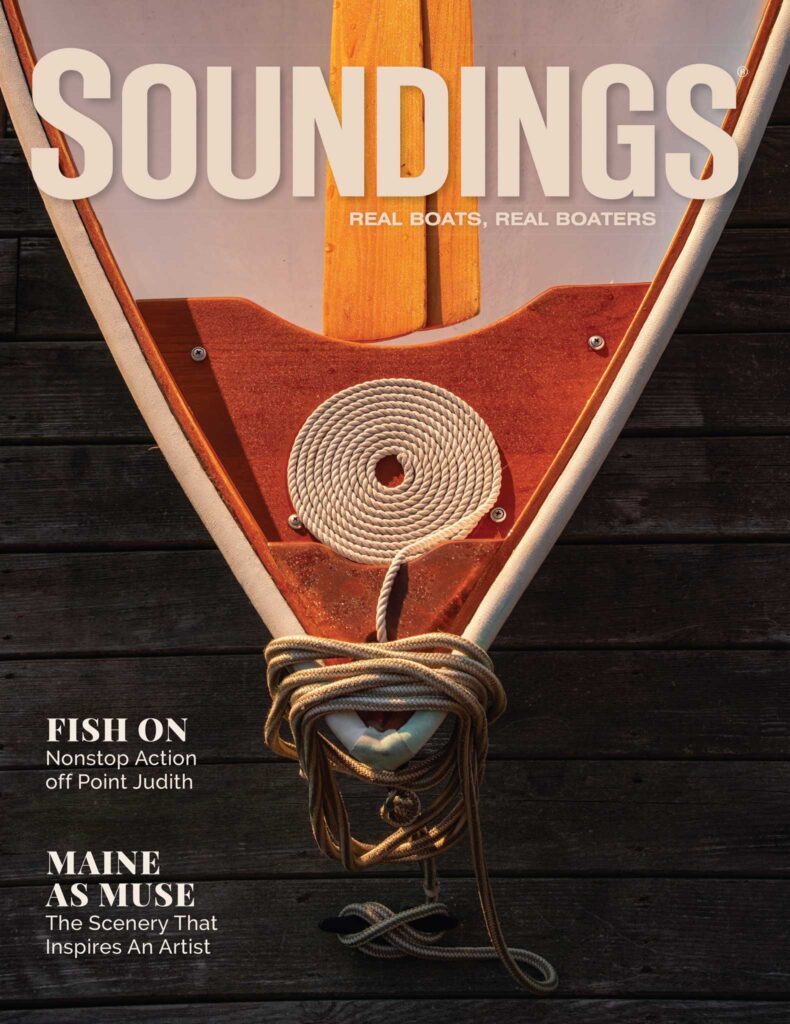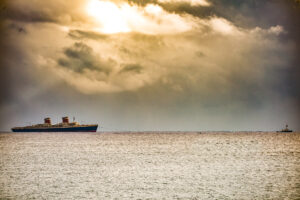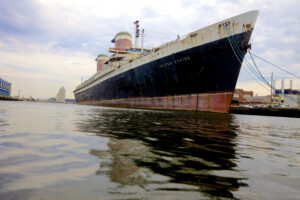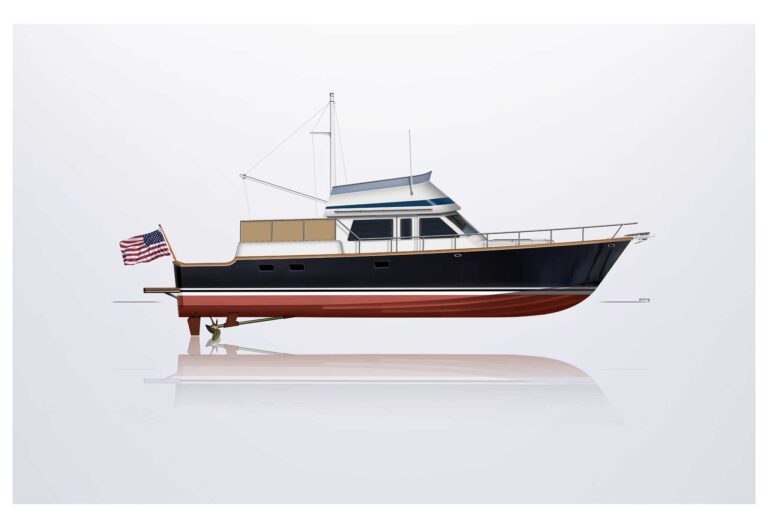In the commercial shipping world everyone associated with the industry across continents and cultures — ship owners and operators, brokers, agents, officials, naval architects, marine engineers, etc. — speaks a common, precise language.
In the commercial shipping world everyone associated with the industry across continents and cultures — ship owners and operators, brokers, agents, officials, naval architects, marine engineers, etc. — speaks a common, precise language. Looking to charter a 45,000-tonne (metric ton) clean-product tanker? The offers from around the world will all be for clean-product tankers of similar dimensions, hull form, propulsion and performance characteristics.
In the boating world, however, Madison Avenue has a hand in shaping the language, which is becoming increasingly vague and misleading. Trawler yachts have become fashionable. And, in my opinion, along with that popularity came the spin meisters hoping to cash in. Those who dream of cruising offshore to distant and exotic places are being offered “fast trawlers” and “express trawlers.” These bear no resemblance to their namesake, the fishing trawler or dragger, and they are, I believe, unsuitable for the adventure.
Boats come in endless varieties, which is what makes wandering about on the waterfront so interesting. A trawler yacht isn’t a better vessel than a high-performance planing boat masquerading as a “fast trawler;” it is just different. But it is better at what it was designed to do, long-range cruising on the open ocean, than a yacht fitted with powerful engines and designed to plane.
What is a trawler?
From far north ports in places like Iceland, the Orkney Islands, Newfoundland, and Alaska and from ports in the far south, little trawlers put to sea in the cold and treacherous waters of the Arctic, North Sea and Southern Ocean every day, even in hurricane-force conditions. Trawlers are the symbol of the seaworthy vessel, stout little ships with a displacement hull, a skeg and a single diesel. Below deck are Spartan accommodations for a small crew, a little pilothouse forward, a galley, engine room and freezer hold. On deck is heavy fishing machinery, such as trawl winches and net rollers.
The little trawler in the drawing is F/V Cressy, a New Zealand design (http://www.starkbros.co.nz). With an LOA of 52 feet, 6 inches, beam of 16 feet, 8-3/4 inches, keel draft of 8 feet, 2 inches and fully loaded displacement of 101.91 tonnes (224,674 pounds), she makes 9 knots powered by a Cummins NTA-855-M 330-bhp diesel running a Twindisc transmission with a gear ratio of 3.92-to-1. The 330 horses turn a 43-inch-diameter four-bladed propeller with a pitch of 43 inches through a steerable nozzle providing a bollard pull of 4.7 tonnes (10,362 pounds).
A trawler is a fishing vessel that drags a trawl and, therefore, typically spends about 90 percent of its voyage towing at slow speed, the balance getting to the fishing grounds and back with its catch. It needs to be exceptionally seaworthy, have a large deadweight (capacity for fuel, fish, provisions, fresh water and the like) and capable of steaming long range, which equates to fuel efficient. The original trawlers usually were designed for midshore services, but many now venture out to what is considered offshore grounds more than 50 miles from land, and their endurances have been increasing.
Cressy has a 1,483-cubic-foot insulated fish hold and a saltwater flake ice machine. She is fitted with two hydraulically driven trawl winches — each with 3,937 feet of half-inch-diameter wire — net roller, unloading winch, etc. There are cramped accommodations for four in the fo’c’sle, with one head and one shower. The fish have the most desirable accommodations on board, while humans are packed like sardines in the fo’c’sle, which is of little use for the business of trawling. Sail with Redmond O’Hanlon in his book “Trawler” (Alfred A. Knopf, 2005) to experience the hard, dangerous and sleepless life of the trawlerman.
What is a trawler yacht?
The irony is that a trawler yacht is rarely used for recreational fishing. Obviously it doesn’t have a fish hold with icemaking machinery or trawl winches and net rollers, and all the available space is dedicated to the comfort of the humans on board. And she lacks speed, which to the recreational angler — the biggest contingent of boaters — is very important, since the time to and from the fishing grounds is time lost to what they live for: fishing. Indeed, recreational anglers can spend a lot of time getting there for a few hours of fishing, just the opposite of their commercial compadres.
What makes the trawler yacht a direct descendant of the fishing trawler is the hull form and propulsion, which enables a big yacht to steam long distances with very little horsepower on the open ocean in boisterous conditions. The stout trawler yachts from Nordhavn are a good example of such a vessel (www.nordhavn.com). They have proved they have the right genes from their commercial cousins by making a circumnavigation under power (Nordhavn 40) and by crossing the Atlantic via Bermuda and the Azores (Nordhavn Atlantic Rally).
A comparison between Cressy and a Nordhavn 47 shows how similar a commercial fishing trawler and a true offshore trawler yacht are. They differ primarily in draft and displacement, differences driven by function. For example, deep draft is a liability on a power yacht often desiring to be in shallow water; also, without a cargo of fish and very heavy fishing gear topside, weight, and therefore displacement, is reduced, which increases hull form efficiency. The disadvantage of decreased draft is a smaller-diameter propeller and correspondingly less propulsive efficiency.
You might conclude from the table that the commercial trawler and the trawler yacht also differ significantly in horsepower. However, Cressy’s 330-bhp main engine has PTO-mounted (power take off) hydraulic pumps for the hydraulic systems, including the winches, and a 17.5 kva alternator. The brake horsepower for propulsion is in the neighborhood of only 215 bhp (see Table 1).
Speed/length ratio (V/?L)
A trawler is, first and foremost, a displacement vessel. The force of buoyancy floats all that weight with no expenditure of energy. Propulsive power must overcome the friction of the hull against the water and what is called the residual resistance of the hull form. Frictional resistance increases at a rate virtually equal to the square of vessel speed. Residual resistance comprises wave and eddy resistance. Wave resistance at low speeds is proportional to the square of the speed but increases much faster at higher speeds, which imposes a speed barrier on the displacement hull form.
In general, very little power is required to push the trawler through the water at speeds, in knots, up to a speed/length ratio (V/?L) of 1.34. When a displacement hull moves through the water it creates a bow wave, and as it approaches a speed of 1.34 times the square root of its waterline length (LWL), this wave is as long as its waterline. Thus, the trawler is sitting between crests, and to go faster tremendous power would have to be expended to climb up on the bow wave — that is, further increases in propulsive power are converted to wave energy with little increase in speed.
Take the Nordhavn 47, with an LWL of 43.33 feet. The square root of 43.33 times 1.34 equates to a speed of 8.8 knots. The spec for the boat gives a cruising speed of 8.5 knots for a speed/length ratio of 1.29. The Nordhavn has a trawler hull shape, and no reasonable addition of power would enable her to exceed a speed/length ratio of about 1.4. She is the cousin of the commercial trawler, built not for speed but for offshore and long-range passages. How long a range? Calculated at a displacement of 65,184 pounds — without taking into account added drag from stabilizers, bow thruster or wing engine — her range in calm water conditions on a consumption of 1,450 gallons with no reserve can be seen in Table 2.
As an example of her deep-sea, long-range capability, the Nordhavn 47 can easily make Hawaii from California with a substantial reserve, even after factoring in reduced performance due to open ocean conditions and the added drag of stabilizers, bow thruster and wing engine.
Prismatic coefficient (CP)
How do you describe a hull mathematically? Naval architects use coefficients and ratios that they know through experience define the hull form they are looking for. The longitudinal prismatic coefficient (CP) is of particular interest to the hydrodynamicist predicting speed and power requirements. It expresses the ratio between the volume of water displaced () and an extrusion of the midship section area (AM) and the LWL (see Diagram A).
By tank-testing and experience, naval architects know what prismatic coefficient gives a trawler the most efficient hull requiring the least power to drive it through the water. Empirical data indicates that the prismatic coefficient of 0.57 for the Nordhavn 47 is pretty much ideal for her speed/length ratio. The prismatic coefficient of Cressy under her inclining conditions is 0.66. This difference is to be expected, since her designers are primarily interested in how much fish she can bring ashore, while the designers of the Nordhavn are primarily interested in cruising range and, therefore, propulsive efficiency. Consequently, the prismatic coefficients are different because of different design objectives.
The effect of the prismatic coefficient on the hull form efficiency of heavy, seagoing trawlers is dramatically illustrated by a test done by the British Fisheries Board and reported in “Voyaging Under Power,” third edition, by Robert P. Beebe and revised by James F. Leishman of Nordhavn (International Marine, 1994). The board built three 62-foot (LWL) fishing boats of exactly the same length and displacement but differing prismatic coefficients.
The results of their test clearly show that the prismatic coefficient is a major concern for the proper design of an offshore trawler yacht (see Table 3).
Displacement/length ratio (?/L)
The displacement/length ratio (?/L) is a non-dimensional measure of the fineness of a hull. Cressy has a dead weight (carrying capacity of cargo, fuel, water, stores, etc.) of 70,638 pounds. Since she carries cargo (fish), her displacement (and, thus, draft) changes significantly between her light and loaded conditions. Since the Nordhavn doesn’t carry cargo, her fully loaded displacement (and draft) is much less; therefore, her displacement/length ratio is much less than Cressy’s. However, in the world of yachts the Nordhavn’s displacement/ length ratio is quite large, indicating a displacement hull with a large capacity for fuel, water, consumables — all the things necessary for long-range cruising.
The most common way to compute displacement/length ratio on this side of the Atlantic is:
?/L = ?/(LWL/100)3 where ? is the displacement in long tons and LWL is in feet.
?/L (as inclined) for Cressy = 79.12 long tons/(50.85 feet/100)3 = 601
Table 4 is an interesting comparison of displacement/length ratios and block coefficients CB for different hull forms from “Naval Architecture For Non-Naval Architects” by Harry Benford (Society of Naval Architects and Marine Engineers, 1991).
Conclusion
I am probably fighting a losing battle, but to my mind, the term “trawler yacht” should be reserved only for displacement hull, slow-speed, single-engine, relatively deep-draft and large-displacement vessels capable of long range on the open ocean. By the numbers, she has a speed/length ratio of 1.34 or less, a prismatic coefficient of about 0.6, and displacement/length ratio close to 300. She is fitted with very low horsepower (by today’s standards) for her displacement and a large-diameter propeller. (Note that the Nordhavn 47’s 173-bhp engine turns a 34-inch-diameter, four-bladed, fixed-pitch propeller with a 30-inch pitch.)
Precision wouldn’t suffer if use of the word “trawler” were expanded somewhat in the yachting world. Perhaps we should call boats like the Nordhavn 47 “offshore trawler yachts” to distinguish them from “coastal trawler yachts.”
Reasonably powered semidisplacement yachts that are nevertheless capable of continuous cruising at displacement speeds and with long ranges and good seakeeping qualities have vastly different characteristics than the offshore variety. They simply aren’t offshore boats. However, when fitted with electronically governed engines — preferably with common rail or HEUI fuel systems — they can operate continuously at low load for long-range coastal and near-offshore cruising and, therefore, are related to the deep-sea trawler. The key phrase is “reasonably powered,” which requires a compromise that sacrifices high-end performance in the interest of keeping the load for displacement speed in excess of 20 percent.
The dimensions and characteristics of such coastal trawler yachts have been defined over the years by such builders as Grand Banks, which lately builds high-performance planing hulls with high-power twin engines, and more recently by Nordic Tugs, which is fitting its coastal trawler yachts with single Cummins MerCruiser (Volvo Penta in the 32) common rail engines. For many power cruisers, few of whom have any desire to venture offshore, a coastal trawler yacht is a more suitable boat than an offshore type.
Opinion
To my knowledge, there are no planing-hull fishing trawlers in existence. There are “high speed” aluminum-hull longliners, but standard midshore trawlers (65 feet or less) always ride displacement hulls. In my opinion, the planing high-powered “fast trawler” or “express trawler” is an oxymoron, a Madison Avenue invention bringing confusion to our understanding of the different capabilities of the endless variety of watercraft. Such boats certainly have their place on the water, but a name or label won’t allow them to perform beyond or outside of what their design (their numbers) allows. Their design is their DNA, and, for better or worse, they’re wedded to it.










